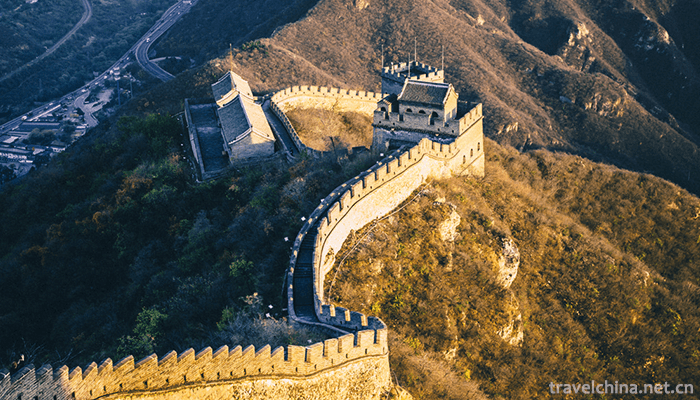The Gu Guan Great Wall
the Gu Guan Great Wall
Guguan Great Wall is located in Xinguancun, Pingding County, Shanxi Province, on the western side of Taihang. It starts at Niangziguan Jiayugou in the north and reaches Baihui Village in the south. It is an important pass of the Great Wall. Guguan Great Wall is the only existing stone-lined Great Wall in China, which is the earliest Great Wall in Ming Dynasty. Luo Zhewen, a famous expert on the Great Wall, calls it "the charm of Xiaobadaling". According to Mr. Luo's textual research, the Guguan Great Wall was built in 369 B.C., 155 years earlier than the Great Wall built after the unification of the Six Kingdoms by Qin Shihuang. Although most of the existing relics are Ming Dynasty buildings, it has a history of 2374 years since its inception, which is rare in China.
Guguan is one of the four famous Guans in the west of Beijing in the Ming Dynasty (the other three Guans are Juyong Guan, Bauhinia Guan and Qianma Guan), which is the "Jingji Fanping". Guancheng was first built in the second year of Ming orthodoxy (1437). It was called "Guguan" at that time. It was built in Jiuguan Village, Niangziguan Town, Pingding County. In the 22nd year of Jiajing (1543), although Taiyuan was close to the Pass, the old city was in danger of being insufficient. So he moved ten miles west to build a new city. He changed the meaning of "Guruojin Tang" to "Guruojin Tang", and later restored the Great Wall on both sides of the Pass. Lushi Spring and Autumn Period refers to one of the "Nine Seizures under Heaven".
geographical position
Guguan Great Wall is located 35 kilometers east of Pingding County, only 2 kilometers away from the junction of Shanxi and Hebei. It is the east gate of Shanxi, 65 kilometers east of Shijiazhuang and 50 kilometers west of Yangquan. Taijiu Expressway and 307 National Highway intersect from here. The traffic is very convenient. They belong to Xinguancun, Niangziguan Town, Pingding County, Shanxi Province.
Basic introduction
History
Guguan has experienced many important historical events, and there are many emperors, generals and officials, literati and Mohists who come and go there in successive dynasties. For example, King Qin cut down the corpses of Zhao and Qin Shihuang and returned to Xianyang, Han Xin's "Battle of Backwater". Guo Ziyi and Li Guangbi calmed down the "Anshi Rebellion". Emperor Kangxi's Western Tour passed through here. Han Yu, Sima Guang, Han Qi, Yu Chenglong, Kong Shangren and others also left excellent poems here.
The Great Wall of Guguan was destroyed by wars and war for a long time. In addition, in the twenty-first year of the Republic of China (A.D. 1932), a simple highway was built. After the founding of the People's Republic of China, 307 National Highway and Taijiu Highway were built across the ancient Great Wall, which inevitably damaged this important cultural relic and monument. After 1998, with the support of superiors and under the guidance of cultural relics experts, Xinguancun, with only 600 people, restored thousands of meters of ancient Great Wall and sentry, Yalou Building, Pharmaceutical Building, Guanmen, Xifeng Temple, 307 National Highway Bridge, Taijiu Expressway Bridge and reappeared the style of Xiongguan Ancient Road at both ends of Guguan by volunteer workers and voluntary donations.
At the end of the Qing Dynasty, Guguan was still intact and its monuments were not damaged. Later, Guguan was subjected to repeated wars and unregulated collapse and disrepair. Especially during the Cultural Revolution, the damage was serious, and ancient buildings such as Forts of city walls were demolished at will. Now, there is only one complete fort, three and a half, and the rest is only a low base; the city buildings are falling, the Yamen and the temples are all demolished, almost in ruins. The old Guguan city can only be seen now.
repair
In October 1998, the first phase of Guguan Great Wall project started smoothly. In order to restore the style of the Great Wall, women and children went to battle, eating pot pulp, fearing hardships and dangers, gathering sand into a tower. It invested 650,000 yuan, of which 240,000 yuan was raised by villagers and 13,000 volunteers. It took nine months to repair 620 meters of the Great Wall in the north, three enemy buildings, two watchtowers on the tower, 150 meters on the ramp and steps, 70 meters on the dam, 30 meters on the guard wall, four hexagonal pavilions in Xifeng Temple and two archway buildings. At the same time, the greening of the west side of the Great Wall was carried out, and the conditions for opening up to tourists were preliminarily met.
The second phase of the project invested 1.5 million yuan to restore the Great Wall across the bridge, Wengcheng, Guanlou and 800 meters of the southern section of the Great Wall of the National Highway. At that time, the confrontation between dangerous buildings and Qingfeng, the dance between ancient roads and Taijiu, the new wind and customs, and the cold iron clothes, also responded to the praise of Professor Luo Zhewen, a famous expert on the Great Wall cultural relics, that the Guguan Great Wall "has the charm of Xiaobadaling".
The ancient Great Wall will stand on the top of Taihang with a brand-new appearance, and the east gate of Shanxi will add a beautiful scenery.
Original name
According to Professor Luo Zhewen, the Great Wall of Guguan, which was built in the Spring and Autumn Period and the Warring States Period in 369 B.C., belongs to the Great Wall of Zhongshan State. It is 155 years earlier than the Great Wall built after the unification of the Six Kingdoms by the First Emperor of Qin. It is the only stone Great Wall in existence in China. From the beginning to today, the ancient Great Wall has gone through more than 2370 years of vicissitudes and battles. It was rebuilt in the 17th year of Wanli in Ming Dynasty (1589). While rebuilding the Great Wall of Guguan, the city was built with three Yamen, commonly known as Dayamen, Eryamen and Sanyamen. Dayamen had three military officers, Emperor Jiajing's fourth uncle, Zhuangyi King, sitting in the town to command; the second Yamen was located in the back street, and the General was responsible for military affairs; the third Yamen was located near Guguanguan Pass, responsible for guarding and collecting customs duties. During the Ming and Qing Dynasties, Guguan was the only way to Beijing. Its terrain was dangerous, and it was the strongest point to protect Beijing. It was one of the eight longs in Taihang and Jiusai in the pre-Qin period. Juyong Pass, Baujingguan Pass, Shuimaguan Pass and Guguan Pass are the four famous passes in the west of Beijing in the Ming and Qing Dynasties, and they are also "Jingji Fanping".
During the Jiajing period of the Ming Dynasty, nomadic bandits in Inner Mongolia often fled to the interior to disrupt, led the army to attack the old customs (the present and the old customs). Because of the insufficient terrain, they were almost overthrown by the bandits. In order to strengthen the defense, Emperor Jiajing ordered to move the Pass and set up a city. The governor of Zhengding Zhili requisitioned more than 2,000 migrant workers from eight counties. He moved Guguan to the west to build a pass and changed it to Guguan, which is now Guguan. This is the origin of Guguan's name. After the overthrow of the Qing Dynasty, Guguan was changed to Xinguancun due to the change of place names.


-
1.yangshuo west street
West Street is nicknamed Foreigner's Street, located in Yangshuo County,
Time 2018-10-12 -
2.Mahjong
Mahjong, originated in China, is commonly known as Sparrow in Guangdong, Hong Kong and Macao. It is a game invented by the ancients of China,
Time 2018-11-13 -
3.Gold medal suckling pig
Roasted Suckling Pig. Characteristic: It has won the "Golden Ding Award" by the national commercial department. It is a precious Cantonese dish at the banquet.
Time 2018-11-14 -
4.Fenghua Xikou Tengtou Tourist Scenic Area
Fenghua District, Ningbo City, Zhejiang Province, is under the jurisdiction of the established towns, the first batch of famous national landscape tourism towns
Time 2018-12-07 -
5.Nine Towers Chinese Folk Happy Garden
Jiudingta Chinese Folk Happy Garden is a large-scale original ecological and cultural tourist area which integrates Chinese national customs, scenic spots, waterfalls, recreational exploration
Time 2018-12-22 -
6.Anxi Tea Grand View Garden
Anxi Tea Grand View Garden in Quanzhou, Fujian Province is located in Fengguan Mountain on the north side of Fengcheng City. It covers an area of 11 mu
Time 2019-01-02 -
7.Xishuangbanna Primitive Forest Park
Xishuangbanna Primitive Forest Park, located in the east of Jinghong and north of Lancang River, is 8 kilometers away from the seat of the state capital.
Time 2019-02-25 -
8.Chentang Sherpa Singing and Dancing
Chen Tang Sherpa Song and Dance is a traditional folk song and dance in the Sherpa community of Tibet. Accompanied by "Zhanlie" (Six Strings) and "Biwang" (Huqin).
Time 2019-04-16 -
9.han opera
Guangdong Hanju Opera, formerly known as "Ran Tan", "Waijiang Opera" and "Xingmei Hanju Opera", is one of the Hakka Opera genres in Guangdong Province
Time 2019-05-01 -
10.String Music Heze String Music
Heze string music is one of the second batch of national intangible cultural heritage announced by the State Council. It is a well-known traditional folk music in southwestern Shandong Province, and i
Time 2019-07-01 -
11.Yongan Daqiang Opera
Yongan Daqiang Opera was formed in the mid-Ming Dynasty. It is a genre of Yiyang Opera. It is called Daqiang Opera because it is "big gong, big drum and big voice singing high tune". During
Time 2019-07-14 -
12.Bai Pu
Bai Po (1226 - about 1306), formerly known as "Heng", Ren Fu, later renamed Pu, the word is too plain, Lanlan Valley, Han nationality, ancestral home state (now Shanxi) Hequ ) Nanjing's Kaif
Time 2019-09-11